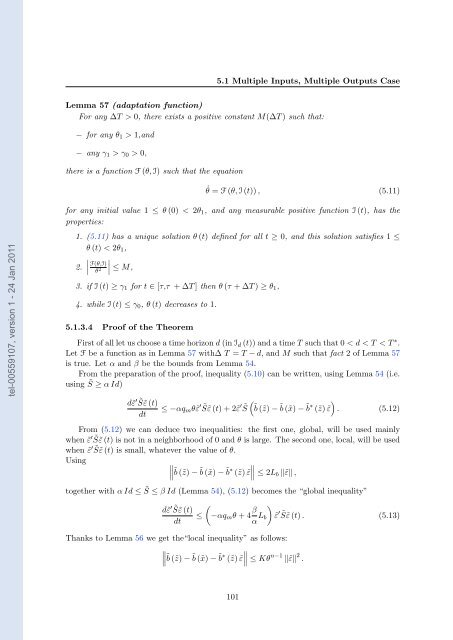Adaptative high-gain extended Kalman filter and applications
Adaptative high-gain extended Kalman filter and applications
Adaptative high-gain extended Kalman filter and applications
Create successful ePaper yourself
Turn your PDF publications into a flip-book with our unique Google optimized e-Paper software.
tel-00559107, version 1 - 24 Jan 2011<br />
5.1 Multiple Inputs, Multiple Outputs Case<br />
Lemma 57 (adaptation function)<br />
For any ∆T >0, there exists a positive constant M(∆T ) such that:<br />
− for any θ1 > 1,<strong>and</strong><br />
− any γ1 > γ0 > 0,<br />
there is a function F (θ, I) such that the equation<br />
˙θ = F (θ, I (t)) , (5.11)<br />
for any initial value 1 ≤ θ (0) < 2θ1, <strong>and</strong> any measurable positive function I (t), has the<br />
properties:<br />
1. (5.11) has a unique solution θ (t) defined for all t ≥ 0, <strong>and</strong> this solution satisfies 1 ≤<br />
θ (t) < 2θ1,<br />
�<br />
�<br />
2. � F(θ,I)<br />
�<br />
�<br />
� ≤ M,<br />
θ 2<br />
3. if I (t) ≥ γ1 for t ∈ [τ,τ + ∆T ] then θ (τ + ∆T ) ≥ θ1,<br />
4. while I (t) ≤ γ0, θ (t) decreases to 1.<br />
5.1.3.4 Proof of the Theorem<br />
First of all let us choose a time horizon d (in Id (t)) <strong>and</strong> a time T such that 0 < d < T < T ∗ .<br />
Let F be a function as in Lemma 57 with∆ T = T − d, <strong>and</strong> M such that fact 2 of Lemma 57<br />
is true. Let α <strong>and</strong> β be the bounds from Lemma 54.<br />
From the preparation of the proof, inequality (5.10) can be written, using Lemma 54 (i.e.<br />
using ˜ S ≥ α Id)<br />
d˜ε ′ ˜ S˜ε (t)<br />
dt<br />
≤−αqmθ˜ε ′ � �<br />
S˜ε ˜ ′<br />
(t) + 2˜ε S˜<br />
˜b (˜z) − ˜b (˜x) − ˜∗ b (˜z)˜ε . (5.12)<br />
From (5.12) we can deduce two inequalities: the first one, global, will be used mainly<br />
when ˜ε ′ ˜ S˜ε (t) is not in a neighborhood of 0 <strong>and</strong> θ is large. The second one, local, will be used<br />
when ˜ε ′ ˜ S˜ε (t) is small, whatever the value of θ.<br />
Using � �<br />
�� ˜b (˜z) − ˜b (˜x) − ˜∗ �<br />
b (˜z)˜ε � ≤ 2Lb �˜ε� ,<br />
together with α Id ≤ ˜ S ≤ β Id (Lemma 54), (5.12) becomes the “global inequality”<br />
d˜ε ′ ˜ S˜ε (t)<br />
dt<br />
≤<br />
�<br />
−αqmθ +4 β<br />
α Lb<br />
�<br />
˜ε ′ S˜ε ˜ (t) . (5.13)<br />
Thanks to Lemma 56 we get the“local inequality” as follows:<br />
�<br />
�<br />
�˜b (˜z) − ˜b (˜x) − ˜b ∗ �<br />
�<br />
(˜z)˜ε � ≤ Kθ n−1 �˜ε� 2 .<br />
101

















